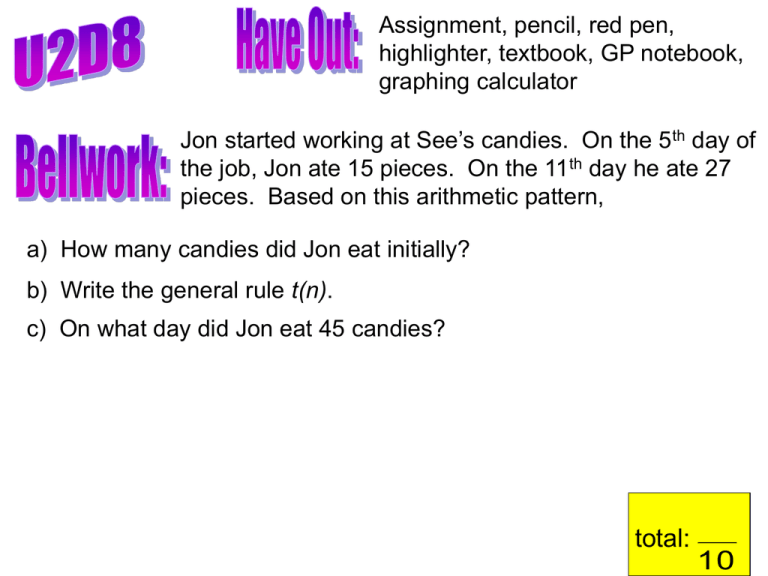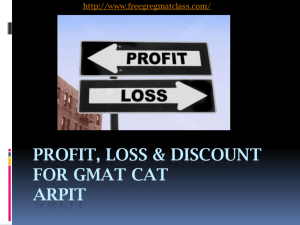Algebra 2
advertisement

Assignment, pencil, red pen, highlighter, textbook, GP notebook, graphing calculator Jon started working at See’s candies. On the 5th day of the job, Jon ate 15 pieces. On the 11th day he ate 27 pieces. Based on this arithmetic pattern, a) How many candies did Jon eat initially? b) Write the general rule t(n). c) On what day did Jon eat 45 candies? total: 10 Jon started working at See’s candies. On the 5th day of the job, Jon ate 15 pieces. On the 11th day he ate 27 pieces. Based on this arithmetic pattern, a) How many candies did Jon eat initially? n 5 11 t(n) 15 27 +1 +1 Common 27 15 12 2 difference 11 5 6 b) Write the general rule t(n). total: 10 t(n) = dn +b 15 = 2(5) + b +1 +1 15 = 10 + b Jon initially ate 5 5 = b +1 candies. t(n) = 2n + 5 +2 c) On what day did Jon eat 45 candies? 45 = 2n + 5 +1 40 = 2n 20 = n +1 +1 Jon ate 45 candies on the 20th day. BB – 85 Starting with x in each case where x represents the original cost, find a simplified form for each increase or decrease. i) a 30% increase 100% + 30% = 130% = 1.30x ii) a 5.2% decrease 100% – 5.2% = 94.8% = 0.948x a) a 5% increase 100% + 5% = 105% = 1.05x b) a 12% discount 100% – 12% = 88% = 0.88x c) a 8.25% tax 100% + 8.25% = 108.25% = 1.0825x d) a reduction of 22.5% 100% – 22.5% = 77.5% = 0.775x BB – 86 Remember the flu epidemic in BB–75? It has become a statewide crisis, but you have also developed a deeper understanding of how a multiplier can help you solve a problem such as this. … a) If Dallas has 1250 cases at the start of the epidemic, with an increase of 27% per week, how many cases would be reported in Dallas after four weeks of the epidemic? 4 Initial value = 1250 t(4) = 1250(1.27) n t(n) t(4) 3252 cases Multiplier = 100% + 27% 0 1250 = 127% 1 1588 = 1.27 2 2016 b) Write the general expression from which you can 3 2560 determine the number of cases in any week of the 4 3252 Dallas flu season. t(n) = 1250(1.27)n n n 1250(1.27) BB – 86 n t(n) 0 1 2 3 4 5 6 7 8 1250 1588 2016 2560 3252 4130 5245 6661 8459 c) If Health Services provided 8000 doses of an experimental medication to fight the virus, when will the medication be used up (assume one dose per person affected)? t(n) = 1250(1.27)n 8000 = 1250(1.27)n 1250 1250 6.4 = (1.27)n Do you have any ideas how to solve this problem???? We cannot solve for the unknown exponent! Let’s just continue the table until we surpass 8000. The medication will be used up at about the 8th week. 1. You and your friend’s favorite shoe store is having a going-out-ofbusiness sale. Sign are posted around the store that state 25% is taken off each day off the cost of items for four straight days. Your friend found a pair of $100 shoes. He decides to wait until the last day to buy the shoes because he thinks that by the 4 th day, the shoes will be free. You tell him that the shoes will not be free on the 4th day. Explain your reasoning to your friend. Your work and explanation should involve the mathematical concepts used in this chapter. Initial value = $100 t(n) = 100(0.75)n Multiplier = 100% – 25% t(4) = 100(0.75)4 = 75% t(4) $31.64 = 0.75 My friend added 25% per day, but he should multiply the percentage to determine the cost. The shoes will cost $31.64 on the 4th day. 2. You are offered the position of CEO for 2 different companies. •Company A pays $250,000 per week. •Your pay rate for Company B is 1¢ for showing up to work on the first day, then the amount doubles per week. For instance, your pay rate for Company B is 2¢ for one week of work, 4¢ for 2 weeks of work, 8¢ for 3 weeks of work, 16¢ for 1 month of work, and so on. The company pays you nothing until the end of 8 months. You get paid whatever the current weekly pay rate is at that time. Which plan would you chose? Show your reasoning to support your decision. Tables are provided below to assist you with your decision. Company A pays $250,000 per week. Company A Initial value = 0 Common difference = $250,000 time: 8 months # of weeks = 8(4) = 32 weeks t(n) = 250,000n + 0 t(32) = 250,000(32) + 0 t(32) = $8,000,000 The total pay for 8 months of work at Company A is $8,000,000. Your pay rate for Company B is 1¢ for showing up to work on the first day, then the amount doubles per week. For instance, your pay rate for Company B is 2¢ for one week of work, 4¢ for 2 weeks of work, 8¢ for 3 weeks of work, 16¢ for 1 month of work, and so on. The company pays you nothing until the end of 8 months. You get paid whatever the current weekly pay rate is at that time. Company B Initial value = 0.01 Multiplier = 2 time: 8 months # of weeks = 8(4) = 32 weeks t(n) = 0.01(2)n t(32) = 0.01(2)32 t(32) = $42,949,672.96 The total pay for 8 months of work at Company B is $42,949,672.96. In the long run, Company B pays more than Company A. BB – 84 Karen works for a department store and receives a 20% discount on any purchases that she makes. Today the department store is having the end of year clearance sale where any clearance item will be marked 30% off. When Karen includes her employee discount with the sale discount, what is the total discount she will receive? Does it matter what discount she takes first? Answer the following questions to find out. Using graph paper, separate two 10 x 10 grids as shown below. Case #1: 20% discount first Case #2: 30% discount first BB – 84 Case #1: 20% discount first Case #2: 30% discount first 100(0.2) = 100(0.3) = 20 squares 30 squares a) Each grid has 100 squares – take the first discount in each case by shading the appropriate number of squares. i) How many squares remain after the first discount in case #1? 80 squares remain after the first discount. ii) How many squares remain after the first discount in case #2? 70 squares remain after the first discount. BB – 84 Case #1: 20% discount first Case #2: 30% discount first 80 (0.3) = 70 (0.2) = 24 squares 14 squares b) Using the remaining squares in each case take the second discount. Note: you no longer have 100 squares to start! i) How many squares remain after the second discount in case #1? 56 squares remain after the second discount. ii) How many squares remain after the second discount in case #2? 56 squares remain after the second discount. BB – 84 Case #1: 20% discount first Case #2: 30% discount first c) When you take a 20% discount, what percent is left? 100% - 20% = 80% d) When you take a 30% discount, what percent is left? 100% - 30% = 70% e) Multiply these results together. What percent do you have now? How does this relate to Karen’s problem above? (80%)(70%) = (0.8)(0.7) = 0.56 = 56% The answer is the same as part (b). It does not matter which discount is taken first. BB – 87 A local real estate developer decides to hire 2 high school students to rake the leaves along a green belt. They will work a couple hours each afternoon until the job is completed. The job is expected to take about 3 weeks. They can choose one of two payment plans: Plan A pays $11.50 per afternoon Plan B pays 2 cents for one day of work, 4 cents for two days of work, 8 cents for 3 days of work, a total of 16 cents for four days, and so on. Each student chooses a different plan. On which day would their pay be approximately the same? Support your thinking with data charts and/or graphs. BB – 87 Plan A pays $11.50 per afternoon Let n represent the number of days worked. n t(n) 0 1 2 3 4 5 0 11.50 Let t(n) represent the total money 23.00 earned on the job. 34.50 46.00 Plan A starts at $0 since no work is 57.50 done initially. … n 11.50n + 0 t(n) = 11.50n n t(n) 0 1 2 3 4 5 0 0.01 0.02 0.04 0.08 0.16 0.32 The pay doubles every day. Even though the person is not paid for just showing up initially, what would the initial value be hypothetically based on the doubling pattern? … t(n) = 11.50n + 0 Plan B pays 2 cents for one day of work, 4 cents for two days of work, 8 cents for 3 days of work, a total of 16 cents for four days, and so on. n 0.01(2)n t(n) = 0.01(2)n BB – 87 Type both equations into you graphing calculator as: Plan A: t(n) = 11.50n Y1 = 11.50x Plan B: t(n) = 0.01(2)n Y2 = 0.01(2)x Go to TABLE to view the values for each function. Answer the question: On which day would each student’s pay be approximately the same? In 14 days they will earn close to the same amount. BB – 88 You favorite radio station, WCPM, is having a contest. The D.J. poses a question to the listeners. If the caller answers correctly, he/she wins the prize money. If the caller answers incorrectly, $20 is added to the prize money and the next caller is eligible to win. The question is difficult and no one has won for 2 days. a) You were the 15th caller today and you won $735!! How much was the prize worth at the beginning of today? Be careful; think about how many times the prize was increased today. b) Suppose the contest starts with $100. How many people would have to guess incorrectly for the winner to get $1360? BB – 88 a) You were the 15th caller today and you won $735!! How much was the prize worth at the beginning of today? Be careful; think about how many times the prize was increased today. n t(n) 0 1 2 3 4 5 6 7 8 9 10 11 12 13 14 15 +20 +20 +20 +20 +20 +20 +20 +20 +20 +20 +20 +20 +20 +20 735 Original prize = $735 – 14($20) = $735 – $280 = $455 b) Suppose the contest starts with $100. How many people would have to guess incorrectly for the winner to get $1360? t(n) = 20n + 100 Initial value = $100 1360 = 20n + 100 Common 63 people would have = $20 1260 = 20n Difference to guess incorrectly. n = 63







